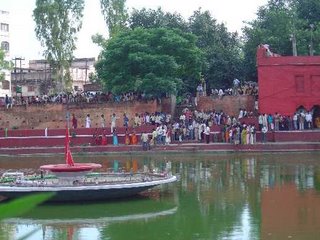Varanasi
 Varanasi claims to be the world's oldest continuously inhabited city. Called Benares in the nineteenth century, it was visited by Mark Twain, who wrote "Benares is older than history, older than tradition, older even than legend, and looks twice as old as all of them put together." That's no longer strictly true, as there are now too many mobile phones for it to be that old.
Varanasi claims to be the world's oldest continuously inhabited city. Called Benares in the nineteenth century, it was visited by Mark Twain, who wrote "Benares is older than history, older than tradition, older even than legend, and looks twice as old as all of them put together." That's no longer strictly true, as there are now too many mobile phones for it to be that old.This picture at right exemplifies Varanasi to me: garish advertisements everywhere, some of which partially obscure the gorgeous carvings on an ancient stone temple, while a cow eats garbage in a narrow alleyway.
(It's tough to convey the randomness of cows in India. In New Delhi they're absent, but that's about the only place. Goats are everywhere, too. While waiting on the train platform in Jhansi (which is not a small city) a cow passed right in front of me, moving between garbage cans looking for food, while dodging porters, well-dressed business people, and pallets of cargo. By then I had been in India a week and had to remind myself that this is kind of odd. I brushed amongst them in the alleyways many times; they're of course quite tame creatures, but I steered (forgive me... forgive!) clear of the two bulls I saw nonetheless)
Varanasi is important to Hindus because of the Ganges, on whose right bank it sits, and because it is believed that to die there is to get a free pass out of the cycle of death and rebirth. For this reason, many small apartments are rented out to devout elderly from all around India, some of whom spend their remaining fortunes to come here and wait to die. Also many Hindu pilgrims come here just to bathe in the Ganges, or improve their karma by giving to the many beggars, so it's a major tourist destination for Indians as well as foreigners. It's also a city of many temples, such as the splendid Durga temple seen here.

Durga is magnificent in its deep red color, but it's frustrating because like all Hindu temples, non-Hindus aren't allowed inside. I walked around the circumference wishing I could go in. This was made worse when I saw numerous swastikas on the outside of the temple, but of course, they are an ancient Aryan symbol, which is why the Nazis chose it and gave it the connotations that make us quiver. No, this is a benign, holy site for Hindus, indeed one of their most sacred and solemn, which is why this was bound to be the place where I encountered Bollywood.
You can see them in the first photo of Durga, but
 the second one focuses in on the film crew- the camera is at the center of the tight knot of people on the right, closest to the water. They were filming one of the musical numbers when I walked by. The soundtrack would blare over speakers, complete with the heroine singing in a register just below canine hearing, and the dancers would move in time along the red steps to the left for thirty seconds, then retreat from the blazing sun until the next take. Huge crowds gathered around all sides of the temple's reflective pool to watch the filming, and a dozen security guards were employed keeping gawkers out of the shot.
the second one focuses in on the film crew- the camera is at the center of the tight knot of people on the right, closest to the water. They were filming one of the musical numbers when I walked by. The soundtrack would blare over speakers, complete with the heroine singing in a register just below canine hearing, and the dancers would move in time along the red steps to the left for thirty seconds, then retreat from the blazing sun until the next take. Huge crowds gathered around all sides of the temple's reflective pool to watch the filming, and a dozen security guards were employed keeping gawkers out of the shot.When its not being used for movie shoots, Varanasi's main claim to fame are the ghats on the bank of the Ganges. Each Hindu king or emperor would want to leave his mark on the holy city by building a ghat, a series of broad steps leading down to the water, to provide a place for the devout to bathe, wash clothes, and eventually be cremated. Only two of the ghats are used for this latter purpose, and one does not photograph them out of respect. In such demand are the services of the "burning ghats" that the fires burn twenty-four/seven. I even saw a body being dressed for cremation in the street while on my way to the river.

Here's a shot of one of the regular ghats at first light, where a group of pilgrims was bathing. It's not my religion, so I shouldn't judge, but setting even a toe in the Ganges seems like a bad idea to me. The water is so polluted that it is now devoid of any dissolved oxygen, and pathogen levels exceed safe numbers by vast factors. Still, it's the holy river.
 I was permitted to photograph the staging grounds for Harish- chandra, one of the burning ghats, from atop a neighboring building, which I did just because the woodpile was so impressive. The bodies are ritually bathed in the Ganges before they're burned, so they're wet when committed to the flames (in addition to all the water in the body already). As such, it takes a lot of very expensive firewood to reduce a body to ash. I saw four fires burning there that day, as relatives stood by and watched for the three to four hours it takes. It was fascinating, so I regret not being able to show you (I'm sure I could have snuck at least one shot), but I know I wouldn't have wanted some amateur anthropologist from the other side of the world photographing my father's funeral.
I was permitted to photograph the staging grounds for Harish- chandra, one of the burning ghats, from atop a neighboring building, which I did just because the woodpile was so impressive. The bodies are ritually bathed in the Ganges before they're burned, so they're wet when committed to the flames (in addition to all the water in the body already). As such, it takes a lot of very expensive firewood to reduce a body to ash. I saw four fires burning there that day, as relatives stood by and watched for the three to four hours it takes. It was fascinating, so I regret not being able to show you (I'm sure I could have snuck at least one shot), but I know I wouldn't have wanted some amateur anthropologist from the other side of the world photographing my father's funeral.From Varanasi it's a seven hour bus ride to Khajuraho, my next destination, so I opted to fly instead. Jet Airways is India's new low-cost carrier, which felt exactly like flying at home. You still know you're in India (the announcements are in Hindi first, obviously) and the meal choice is "Veg or non-veg?" ("Non-veg" is the subordinate category. God I love this cuisine!). An hour after boarding, I stepped off their brand new 737 in tiny but ancient Khajuraho.


0 Comments:
Post a Comment
<< Home